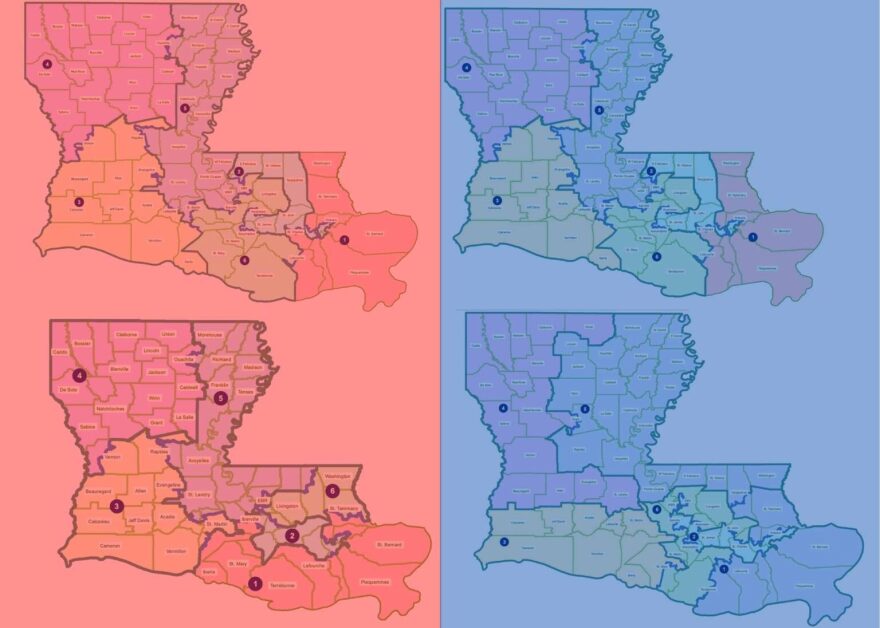This story was originally published by the Louisiana Illuminator.
Louisiana lawmakers have so far filed seven maps to consider in a special session brought about after a federal court rejected a congressional redistricting proposal they approved earlier this year. The judge in the case has given legislators until Monday to submit a map with two majority-Black districts in order to comply with the Voting Rights Act.
Judge Shelly Dick ruled June 6 in favor of a group of Black voters who sued after just one Black district was included in the map that the Legislature’s Republican majority advanced from a February redistricting session. Gov. John Bel Edwards vetoed the bill with those boundaries on the same grounds, but lawmakers overrode his rejection largely along party lines.
Debate on one of the proposed maps took place Thursday, but a Senate committee declined to advance Sen. Cleo Fields’ bill that features two majority-Black districts. Alternatives will be considered Friday when House and Senate redistricting committees meet.
What follows is a breakdown of the seven maps filed for the special redistricting session. For anyone wanting more information on the makeup of the proposed congressional districts, each segment has a link to the actual bill. The linked file includes a breakdown of voting precincts, resident and voter demographics and more detailed maps of each district.
SENATE BILL 1, Sen. Cleo Fields, D-Baton Rouge

The Fields’ proposal features keeps the 2nd Congressional District majority Black and turns the 5th District into a Black-majority seat. The Black population in the proposed 5h District would be 54% Black and 51% Black in terms of residents who have reached voting age.
Although it splits fewer parishes than the Republican-backed maps, Senate Bill 1 notably cleaves the city of Slidell. That’s the home of Senate and Governmental Affairs Committee chair Sen. Sharon Hewitt, the Republican who leads redistricting for the chamber.
The 1st Congressional District is altered dramatically in the Fields’ proposal, stretching it westward to encompass more coastal parishes. The 6th District becomes largely based in the Florida Parishes in SB 1.
Fields was amenable to an amendment to remove a split in Vernon Parish, but the committee voted against advancing his bill to the Senate floor.
SENATE BILL 2, Sen. Sharon Hewitt, R-Slidell

Hewitt’s bill sticks with one majority-Black district, the 2nd, that draws most of its constituency from New Orleans and spans upriver to portions of Baton Rouge. The consistent argument for the map from Hewitt is that it all but guarantees one Black representative for Louisiana in Congress, and any other option to add a second minority district would only serve to water down the strength of the Black vote.
SENATE BILL 3, Sen. Rick Ward, R-Port Allen

Ward filed his proposal for redistricting Thursday. It includes two majority-Black districts, the 2nd and 6th. The Black majorities are very slim in both districts, each totaling 50% in terms of Black people of voting age.
The altered 6th District in Ward’s bill replaces the River Parishes in the existing boundaries with northern portions of the Florida Parishes, currently part of the 5th District, and stretches into Central Louisiana. Another major change takes the 3rd District and stretches it across the state’s coastline.
For what it’s worth, Ward has announced he will step down from office a year early to take a job in the private sector.
HOUSE BILL 1, Rep. Royce Duplessis, D-New Orleans

The Duplessis proposal mirrors Senate Bill 1, in which the 2nd and 5th districts are majority Black. It is being considered Friday in the House and Governmental Affairs Committee.
It’s worth noting the same map was submitted during February’s redistricting session. Although it wasn’t advanced from committee, the fact that it existed has been mentioned in the lawsuit that attempts to block the GOP-backed congressional districts from taking effect.
When Republican legislative leaders have argued that more time is needed to review the proposals, Judge Dick has pointed out that this version with two majority-Black districts has been in the public realm for quite some time.
HOUSE BILL 2, Rep. Clay Schexnayder, R-Gonzales

The House speaker’s bill keeps five majority-white districts intact. Schexnayder insists the makeup passes muster with the Voting Rights Act, although that decision could well be left up to the U.S. Supreme Court.
Schexnayder and Senate President Page Cortez, R-Lafayette, were denied Thursday when they asked Judge Dick for more time to approve new congressional districts. The fact that the speaker gave the House the day off Thursday, rather than start hearing bills in committee, likely was a factor in the judge’s decision.
At Friday’s House redistricting committee hearing, Schexnayder told members he would not move for a vote on this bill.
HOUSE BILL 3, Rep. Barry Ivey, R-Baton Rouge

The first of two proposals from Ivey shakes up the 5th District, which would have a 54% Black population and 51% of its voters Black. His boundaries rework the 2nd District to take it north of Baton Rouge, putting its old Capital-area precincts into the 5th.
That Ivey has put forth two bills stands out because he ended the February redistricting session with a bad taste in his mouth. Colleagues had refused to bring up his proposal to add another minority district to the Louisiana Supreme Court, leading Ivey to launch into pointed invective on the House floor.
Ivey also refused to sponsor any bills in the regular session and held true to his word.
HOUSE BILL 4, Ivey

The second bill from Ivey also creates Black-majority districts with the 2nd and 5th, but with only the slightest edge in Black voters.
To make the numbers work, the 6th District becomes decidedly less compact, fanning out across the Mississippi River near Baton Rouge to reach into Acadiana, the Bayou Region and into Livingston and East Feliciana parishes.


